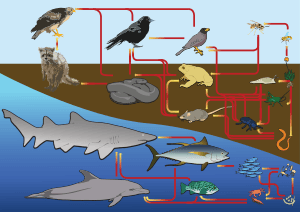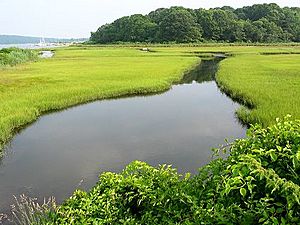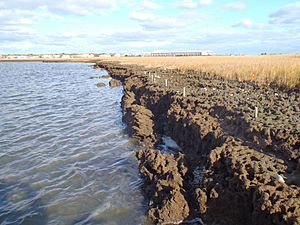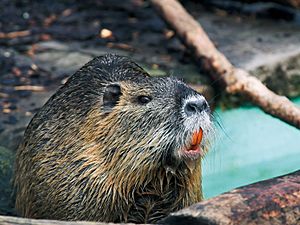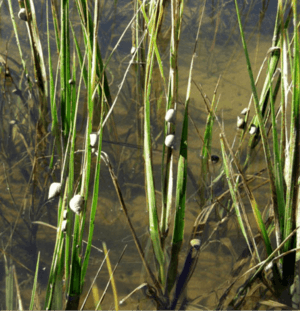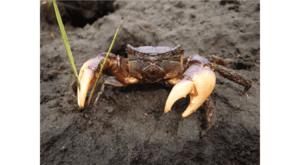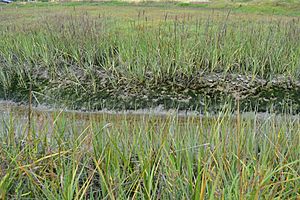Salt marsh die-off facts for kids
Salt marsh die-off is when large areas of salt marsh plants, especially a type of grass called cordgrass, start to die. This usually happens in the lower parts of the marsh, near the water. Cordgrass is super important because its roots hold the soil together. When it dies, the soil becomes soft, the land starts to wash away, and creek banks can collapse. This makes the marsh unhealthy and less productive.
Several types of cordgrass, like S. alterniflora, S. densiflora, and S. townsendii, can be affected. Scientists have different ideas about why this die-off happens along the Atlantic coasts. Some think it's due to "top-down" reasons (like animals eating too much), while others believe it's "bottom-up" (like problems with the soil or nutrients). Salt marsh die-off, along with dieback in the higher parts of the marsh, is a big problem because marshes provide many helpful things for coastal communities.
Contents
Understanding Food Webs: Top-Down vs. Bottom-Up
In ecology, scientists study how living things interact, especially when one eats another. They use food webs to show all the feeding connections in a community of living things.
Food webs can be controlled in two main ways:
- Bottom-up control: This means the food web is mostly shaped by the amount of food available at the bottom, like nutrients and plants. If there's lots of plant food, there can be more animals that eat plants, and then more animals that eat those animals.
- Top-down control: This means the food web is mostly shaped by the top predators. If there are many predators, they can keep the numbers of their prey (the animals they eat) low.
A lot of energy is lost as it moves up from one trophic level (feeding level) to the next. So, the success of animals higher up the food chain depends on the resources available at lower levels. However, the number of animals in an ecosystem is also affected by how many consumers (animals that eat others) are around. These consumers can limit the success of organisms at lower levels.
For a long time, many ecologists thought that bottom-up control was the most important. They noticed that many ecosystems, like forests and salt marshes, were mostly green with plants, and they thought this was because plants were not heavily eaten. But then, other scientists suggested that the "world is green" because top predators keep the plant-eating animals (herbivores) in check.
More recently, scientists have found many examples where top-down control clearly shapes entire ecosystems. For instance, if you remove starfish from a rocky shore, their prey, blue mussels, can grow out of control. Another example showed that snails can control the types of algae found in tide pools. These examples show that consumers can have a much bigger impact than once thought.
How Salt Marsh Ideas Have Changed
Early studies of salt marshes focused on how physical things like temperature, salinity (saltiness), and nutrients affected plant growth. They believed that marsh plants were not eaten much and mostly became detritus (dead organic matter) before entering the food chain. This idea meant that animals eating plants didn't play a big role in how productive salt marshes were. This view was widely accepted for many years.
However, newer research has shown that animals like snails, crabs, and geese can have a strong "top-down" control on marsh plants. Other grazers, like wild horses, cattle, hares, insects, and rodents, can also greatly reduce plant growth.
For example, in South American salt marshes, a type of grapsid crab can control the plants. Experiments in different places have shown that consumers are important on a small scale. They can even affect plant growth across large areas.
Some scientists also suggest that while salt marshes might have been controlled by nutrients in the past, human activities like pollution (eutrophication) and reducing predator numbers have shifted these systems towards top-down control in recent decades.
Why Salt Marshes Are Dying Off in Different Places
Both top-down and bottom-up reasons are thought to cause salt marsh die-off. How important each factor is depends on the specific conditions of each marsh.
Top-Down Reasons
Human activities can start a "trophic cascade". This happens when top predators are removed, which allows their prey to increase in number. These increased prey then eat too much of the next lower trophic level, often the plants. Trophic cascades can turn green areas into barren ones. Human actions that can cause this include bringing in invasive species, overfishing, and climate change.
Invasive Species
When humans bring new species into an area, they can also contribute to marsh die-off. For example, wild horses introduced to barrier islands in the US have completely destroyed marsh ecosystems. The introduced nutria rodent in Louisiana's Gulf Coast marshes can also reduce marsh plant growth.
Interestingly, the invasive green crab (Carcinus maenas) can sometimes help marshes recover. In marshes where die-off happened because of too much recreational fishing, the larger green crabs can chase away purple marsh crabs (Sesarma reticulatum), which eat the cordgrass. By eating the purple crabs, green crabs indirectly help the cordgrass grow back. This shows that sometimes, invasive species can actually help restore damaged ecosystems.
Fungal Infections
Die-off could also be caused by pathogens (germs) that attack salt marsh plants. Fungi have been found at die-off sites in the UK and along the US Atlantic and Gulf coasts. For example, marsh snails (Littoraria irrorata) make small cuts in cordgrass when they graze. These cuts can allow fungi to grow, and if there are many snails, it can lead to widespread infections and die-off.
In New England, the link between fungi and die-off is less clear. While some fungi were found more often at die-off sites, there isn't strong proof that they are the main cause of die-off there.
Overfishing
Overfishing has caused many shallow-water marine ecosystems around the world to collapse, including coral reefs, sea grass beds, and kelp forests.
Commercial Fishing
Research on the salt marsh snail Littoraria irrorata shows how overfishing can cause marsh problems. These snails can turn tall cordgrass into mudflats in less than a year! As mentioned, they cut the cordgrass leaves, which helps fungi grow. If there are too many snails, the cordgrass gets infected and dies.
Normally, blue crabs and terrapin turtles eat these snails and keep their numbers in check. But these predators have been overfished, and their populations are now small. This means the snails are free to eat too much cordgrass, causing widespread damage.
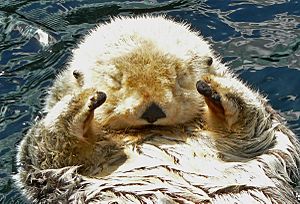
A famous example of a trophic cascade happened when sea otters were overhunted in the 1980s. Sea otters eat urchins, and urchins eat macroalgae. When sea otters were hunted almost to extinction for their fur, the urchin populations exploded. These many urchins then ate all the macroalgae, creating "urchin barrens" where there was no plant life. When sea otters were brought back, the urchin numbers went down, and the kelp forests grew back, making the habitat healthy again. This shows how bringing back predators can help an entire ecosystem recover.
Recreational Fishing
In New England, too much recreational fishing has led to widespread marsh die-off along creek banks. The night-active purple marsh crab (Sesarma reticulatum) is a big part of this problem. These crabs are digging more burrows and eating more plants because their predators are gone.
Scientists found that recreational anglers (people who fish for fun) were only seen at die-off sites. These die-off marshes had half the number of top predators (like blue crabs and fish such as striped bass) compared to healthy marshes. The crabs at die-off sites ate four times more grass. Historical records show that healthy marshes lost very little land, but die-off marshes started losing land rapidly in the mid-1970s, around the same time that many docks and boat slips were built for fishing. This suggests that recreational overfishing is causing a trophic cascade, leading to the widespread die-off in southern New England.
Scientists think that large-scale commercial overfishing in the past made marshes more vulnerable. Then, local recreational fishing pushed them over the edge, causing large areas to die off. If overfishing continues, these local die-offs could combine into a complete, region-wide marsh collapse.
Recent experiments have also shown that when top predators are kept away from marsh areas, Sesarma crabs increase, and they eat so much that die-off happens quickly. Studies found that crab eating explained over 70% of the die-off differences between sites, while other factors like pollution or boat waves did not. This strongly suggests that top-down interactions are the main reason for these changes in the marsh.
Bottom-Up Reasons
Salty and Oxygen-Poor Soils
One idea for bottom-up control is that differences in soil chemistry cause die-off. For example, droughts can make soils more salty and acidic. While salt marsh plants can handle a lot of salt, very high salt levels have been linked to reduced plant survival. However, increased saltiness isn't always seen at die-off sites.
It's hard to be sure about the link between soil conditions and die-off. Sometimes, the soil changes might be a result of the die-off, not the cause. For example, higher salt levels in die-off areas might happen because the plants are gone, which changes how water evaporates from the soil.
Pollution (Eutrophication)
Adding too many nutrients to water, called eutrophication, is a big problem for marine and land ecosystems. In marine areas, too much nitrogen can cause harmful algal blooms, areas with no oxygen, and big losses for fisheries. In salt marshes, some scientists think that too many nutrients contribute to widespread die-offs.
One study in Massachusetts found that adding nitrogen and phosphorus to tidal creeks caused plants to grow fewer roots, increased the breakdown of organic matter, and eventually led to creek collapse and marsh loss.
However, similar studies in Connecticut did not find the same results. They found that adding nutrients didn't cause land loss or reduce carbon in the soil. They suggested that other processes might balance out the negative effects of high nutrients.
Other studies in Rhode Island found that while adding nitrogen first made plants grow more, it eventually led to fewer plants because insects ate them more. This suggests that pollution can actually trigger more insect eating, which then harms the marsh.
How Problems Can Work Together
Coastal ecosystems face many problems caused by humans, like pollution, changes in food webs, climate change, and habitat destruction. These problems rarely act alone. Often, they work together, making the damage even worse.
For example, in the southeastern United States, the loss of top predators led to snails eating too much cordgrass, causing die-off. But this die-off was also linked to severe droughts, which made the soil saltier and more acidic. Drought stress, possibly from climate change, can make cordgrass more vulnerable to being eaten. These examples show how non-living factors (like drought) and living factors (like snails) can interact to affect the health of an ecosystem.
Human actions can also cause eutrophication (too many nutrients) in marine ecosystems through runoff from farms, sewage, and other sources. This pollution can indirectly start trophic cascades and increase how much consumers eat plants. For instance, insect eating in Atlantic salt marshes has been linked to more available nutrients. In Narragansett Bay, human-caused nitrogen additions can increase insect eating so much that plant growth is greatly reduced.
Another example is how eutrophication led to a trophic cascade involving snow geese in the arctic marshes of Hudson Bay. The geese started feeding in heavily fertilized farm fields, causing their population to explode. These many geese then destroyed hundreds of thousands of acres of wetland by eating plant roots. This led to more evaporation, saltier soil, and no oxygen in the soil, making it impossible for new marsh plants to grow. This shows how human use of artificial fertilizer far away can start a trophic cascade that destroys a marsh.
A big goal for scientists in the future is to understand how ecosystems will react to current and future human impacts, and how these impacts combine to cause damage.
Why Salt Marshes Matter and How We Can Help
Ecosystem services are the benefits that humans get from nature. Protecting salt marshes is important because they provide many of these services:
- They clean water by removing nitrogen from runoff before it reaches estuaries.
- They provide safe homes for young fish and crustaceans, supporting coastal fisheries that provide most of the world's fish.
- They store carbon, which is important as climate change gets worse.
- Perhaps most importantly, they act as natural barriers against the sea. Their grasses hold the soil, prevent erosion, reduce wave energy, and lessen coastal flooding.
However, when marsh creek banks die off, the marsh's ability to protect against erosion and flooding can be reduced. Since cordgrass helps bind soil and build up land, its die-off can make it harder for marshes to keep up with sea-level rise. Also, the many burrows of Sesarma crabs in New England salt marshes can directly cause the marsh's foundation to erode and collapse.
On Cape Cod, marsh creek banks are often so full of Sesarma burrows that they fall apart, exposing fresh soil to more burrowing and erosion. This means that the crabs eating the plants and the die-off can create a cycle that causes the marsh edges to shrink. For example, studies found that 20 years of die-off on Cape Cod led to the loss of land that took over 200 years to build up. The harmful effects of trophic cascades not only reduce the biodiversity and health of these ecosystems but also make it harder for marshes to provide important services to people.
What We've Learned
Even with growing evidence, many people still manage salt marshes as if only physical factors control them. However, the loss of top predators around the world, which allows plant-eating animals to increase, might be the biggest current threat to salt marshes. This oversight happens because people tend to stick to old ideas, even when new evidence suggests otherwise. As a result, serious threats to salt marshes caused by top-down control are being missed, which could have terrible consequences.
Trophic cascades are powerful interactions that greatly affect biodiversity, how communities are structured, and how ecosystems work. They were once thought to be rare, but now it's clear they happen in many different land, freshwater, and marine ecosystems, both in small and large areas. Trophic cascades are common, even in communities that were long thought to be controlled only by bottom-up forces.
Because of this, efforts to protect ecosystems affected by trophic cascades haven't fully included top-down control in their plans. But new research shows that this is necessary to protect the services these ecosystems provide and to restore them to their original healthy state. If we don't do this, trophic cascades could turn diverse and productive plant communities into barren, empty areas.
Also, if we don't rethink our current ideas and understand that both bottom-up and top-down forces affect many parts of an ecosystem, and that these forces work together rather than against each other, we might fail to include both in our management plans. This could reduce the success of conservation efforts before they even begin.
Images for kids
-
Salt marsh die-off in Saquatucket, Cape Cod, Massachusetts, USA


